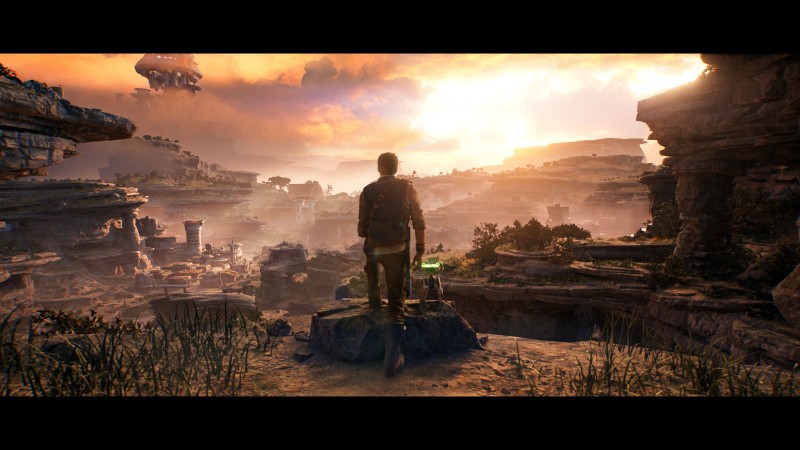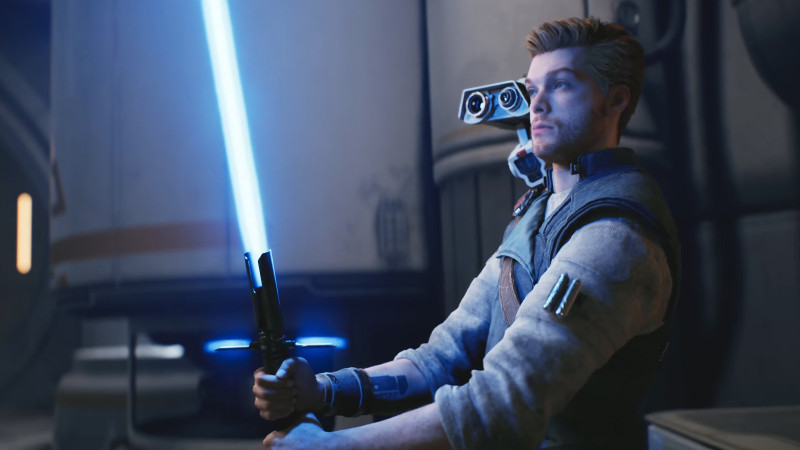Star Wars Jedi: Survivor is a fantastic game, largely due to the fact that it does such a good job of mimicking the Star Wars cinematic style. Whether it’s the rush of stars streaking past a ship going into hyperspace or the distinct hum of a lightsaber, Respawn really went all out to match the aesthetic of one of the world’s biggest movie franchises. One of the most important elements in achieving that is through music, and while the Star Wars sound is iconic and well-known, a good video game score has to be more than just an imitation of what came before. The music for Jedi: Survivor was written by Stephen Barton and Gordy Haab, and when I ask them what makes a good video game soundtrack, they answer in unison.
“Emotional weight.”
Our interview is done on a video call with each composer in a different location, so the act of them responding with the exact answer at the same time is especially surprising and notable – they later explain that it’s a philosophy they’ve shared while working on the scores for Star Wars Jedi: Fallen Order and Survivor.
Barton gestures to Haab, who elaborates on the point. “It’s the same thing that makes a great film score,” he says. “It needs to fill the gap between the player, in this case, or if it’s a film, the audience, and the screen.” In other words, they want the music to enhance the emotion that protagonist Cal Kestis (or whoever is on screen) is feeling and allow the player to feel that as well. It’s not as simple as writing an all-purpose combat theme; a fight can be epic, frantic, or tragic, and the music should reflect the proper emotion. They reiterate that their music is not something that needs to call attention to itself. It’s an element that acts in service of the narrative.
Haab and Barton mention film as a reference point, which is fitting, given the franchise they’re working on. While they still write within the structure of a video game, the music has to “feel” like Star Wars, which inherently has a cinematic quality thanks to its roots on the big screen. They don’t find that framework restrictive, however. According to Barton, the idea of the “Star Wars sound” has changed a lot over the years, especially recently.
“I think it’s a really interesting moving target,” Barton says. “Mandalorian and Andor have been really good examples, I think, of things that have extended [the sound], where now people go, ‘Yeah, that’s Star Wars.’ Whereas if you said to someone ten years ago, ‘Hey, the recorder is gonna be a really important instrument to Star Wars,’ people would have been like, ‘What? Really?'”
Haab, who has experience scoring other Star Wars games like EA’s Battlefront series and Star Wars: Squadrons, nods in approval. “Stylistically, we tend to take inspiration from the things that inspired the original scores,” he adds, “rather than trying to stick really close to the bone on the original scores themselves.”

With Jedi: Survivor, the duo strove to “stretch the sound out a little further.” A great example of this is in the track “A Frontier Welcome.” After some ominous percussion at the start, there’s a series of notes played in unison by a bassoon and some strings. Out of context, I would not associate the track with Star Wars at all, until the composition passes the melody over to the classic Star Wars sound of a high-pitched, suspended woodwind chord. It’s a fitting musical choice to use an unfamiliar sound in this piece since it plays when Cal lands on Koboh, a planet unfamiliar to both him and the audience. Just as Haab and Barton said, the music brings the experience of the player and the game closer together.
In general, the score for Survivor has a much darker tone compared to the score for Fallen Order, which Haab says had an “underpinned hopefulness” to it. In Survivor, Cal’s life is much more complicated, and the game is defined more by the oppressive nature of the Empire. Because of its thematic importance, Haab says they needed to create a melody to represent the omnipresence of the empire.
Referring to the theme, Haab says, “The shape of it, the contour of it, outlines the sinus rhythm of a heartbeat, so there’s this feeling of something always pounding in your heart, you know, in the distance.” He goes on to say that it includes all 12 notes of the chromatic scale – in other words, the notes don’t fit cleanly into one key, so the theme is constantly shifting and creates a sense of unease. It’s not as tidy as the classic Imperial March from the original trilogy because it’s not meant to represent an army of stormtroopers lined up in neat rows; it’s the dread of the idea of the Empire and the despair it represents.
Aside from the tone, the other major shift between Survivor and Fallen Order is the level design. While Fallen Order stuck to a fairly linear style of world design, Survivor has more open areas that the player is free to explore as they wish. To accommodate for this, Barton says they have more “systemic music,” which is built on logic systems and playlists. Certain parts of the music will enter or exit the mix depending on where the player is and what they’re doing.

“We knew at the outset that the campaign was going to be the size that it was,” Barton says. “Our overriding thing is that we don’t want you to feel like you’re ever hearing the same piece of music twice.” Even coming back to the same location later in the game doesn’t mean the music will be the same – there’s that focus on emotional weight again – because Cal might not feel the same about a certain area after the events of the main story. For example, they say the planet Koboh starts off with a “Wild West” sort of feel, but when you arrive after a particularly tragic event in the plot, the atmosphere loses some of that whimsy, and the score (along with all of its logic systems) adapts to reflect that. Barton says they’re also not afraid to let the soundtrack take a break sometimes, pointing a finger toward other elements of sound design in the environment that would immerse a player.
One symptom of this systemic score design is that each music cue doesn’t necessarily fit into one linear piece of music, so when it comes time to assemble a soundtrack to be released separately from the game, the composers have some more work to do.
“We actually independently sort of made a list and marked pieces of music based on priority,” Haab says. “And then we both made our lists and compared them.” Ultimately, they cut down their eight hours of music into a four-hour album, but the process of curating those pieces into something narratively cohesive took months. Sometimes, they even created soundtrack-specific edits to combine several smaller cues into a more complete track. A music cue labeled “Jedah_700” was combined with a number of similar cues to become Track 38, “The Visitor.”
Ultimately, the soundtrack to Jedi: Survivor works so well for the same reason the game as a whole does – it takes classic elements from Star Wars and transforms them into something simultaneously familiar and novel. Haab’s approach to the project exemplifies this perfectly.
“I’m taking a palette that already exists,” Haab says, “And now I’m painting my own completely original painting. But I’m using the same colors.”
Denial of responsibility! My Droll is an automatic aggregator of Global media. In each content, the hyperlink to the primary source is specified. All trademarks belong to their rightful owners, and all materials to their authors. For any complaint, please reach us at – [email protected]. We will take necessary action within 24 hours.


